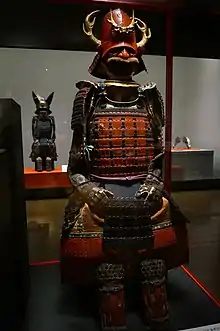Toyotomi Hidetsugu | |
|---|---|
豊臣 秀次 | |
 Toyotomi Hidetsugu | |
| Imperial Regent of Japan | |
| In office 1585–1591 | |
| Monarch | Go-Yōzei |
| Preceded by | Toyotomi Hideyoshi |
| Succeeded by | Kujō Kanetaka |
| Personal details | |
| Born | Miyoshi Nobuyoshi 1568 Chita District, Owari Province, Japan (current Chita District, Aichi, Japan) |
| Died | August 20, 1595 (aged 26–27) |
| Parents |
|
| Relatives |
|
| Other names | Hashiba Hidetsugu |
| Signature |  |
| Military service | |
| Allegiance | |
| Battles/wars |
|
Toyotomi Hidetsugu (豊臣 秀次, 1568 – August 20, 1595) was a daimyō during the Sengoku period of Japan. He was the nephew and retainer of Toyotomi Hideyoshi, the unifier and ruler of Japan from 1590 to 1598. Despite being Hideyoshi's closest adult, male relative, Hidetsugu was accused of atrocities and attempting to stage a coup after the birth of Hideyoshi's son, and he was ordered to commit suicide. Hidetsugu's entire family, including children, were also executed on Hideyoshi's orders. His death and that of his family contributed to the quick dissolution of Toyotomi authority after Hideyoshi's death three years later.
Biography

Hidetsugu was born to Tomo (Hideyoshi's elder sister) with Miyoshi Kazumichi and later adopted by Miyoshi Yoshifusa, his name was Miyoshi Nobuyoshi. He later renamed himself Hashiba Hidetsugu, in honor of his famous uncle: "Hashiba" was the Hideyoshi's family name, and "Hidetsugu" can be translated as "next Hide".
After the Incident at Honnō-ji in 1582, Hidetsugu was given a 400,000 koku fiefdom in Ōmi Province because he was one of Hideyoshi's few relatives. In his subsequent career as a general, during Battle of Shizugatake 1583, he held Oiwayama-fort (大岩山砦, Oiwayama-toride) with Takayama Ukon and Nakagawa Kiyohide and he sustained heavy losses in the Battle of Nagakute 1584 against Tokugawa Ieyasu.
He proved himself in Hideyoshi's Invasion of Shikoku[1] and Siege of Odawara. He also proved a competent manager of the castle town of Ōmihachiman.
A practitioner of the shudō tradition, Hidetsugu had a number of wakashū. Among these were Yamamoto Tonoma, Yamada Sanjuro, and his most beloved, Fuwa Bansaku (also Mansaku), who gained lasting renown for his beauty of body and spirit.[2]
In 1590, (Tenshō 18), he was appointed castellan of Kiyosu Castle in Owari Province, where Oda Nobukatsu had once ruled. The following year, Hideyoshi lost his legitimate heir Tsurumatsu (who died before adulthood) and so gave Hidetsugu the position of Imperial Regent. This meant Hidetsugu had to move to Jurakudai in Kyoto, and resulted in a so-called "dual system of government" (二元政治) run by Hideyoshi and Hidetsugu, with the assumption that latter would succeed the former after his death. As Hideyoshi was busy handling the invasion of Korea, Hidetsugu acted in his place to handle domestic affairs.
However, in 1593, Hideyoshi's concubine, Yodo-dono, gave a birth to a new heir, Hideyori, and the relationship between Hidetsugu and Hideyoshi began to deteriorate. Rumours spread of Hidetsugu committing repeated and unjust murder, earning him the nickname "life-killing kanpaku" (殺生関白, sesshō-kanpaku) – although modern historians doubt that these rumours were accurate.
Finally, in 1595, Hidetsugu was accused of plotting a coup and ordered to commit ritual suicide at Mt. Koya. Together with him died his three wakashu, who committed suicide with his assistance.[3]
Daimyō associated with him were confined and the Jurakudai was destroyed. Controversially, Hideyoshi ordered the execution of Hidetsugu's entire family, including children, wives and mistresses, at Sanjogawara. The harshness and brutality of executing 39 women and children shocked Japanese society and alienated many daimyō from Toyotomi rule. Combined with the fact that Hidetsugu was the last adult member of the Toyotomi clan besides Hideyoshi himself, the whole incident is often seen to be one of the key causes of the Toyotomi's downfall. In a particularly tragic case, Hideyoshi refused to spare the life of Mogami Yoshiaki's 15-year-old daughter, who had only just arrived in Kyoto to become Hidetsugu's concubine and had not yet even met her husband-to-be. Her death caused the powerful Mogami clan to zealously support Tokugawa Ieyasu in the Battle of Sekigahara against Toyotomi loyalist forces, five years later.
Only two daughters of Hidetsugu's children were spared: Kikuhime, one month old, who was adopted by her grandfather's nephew, Gotō Noriyoshi and Ryūsei-in who became Sanada Yukimura's concubine.
Family
- Father: Miyoshi Kazumichi (1534–1612)
- Mother: Tomo (1534–1625)
- Siblings:
- Toyotomi Hidekatsu (1569–1592)
- Toyotomi Hideyasu (1579–1595)
- Wives, Concubines, and children:
- Wife: Ikeda Tsuneoki's daughter, called "Waka Mandokoro"
- Wife: Ichi no Dai (1562–1595), daughter of Imadegawa Harusue
- Daughter: Ryūsei-in (d.1633), Sanada Yukimura's concubine
- Concubine: Kogami-dono (d.1595), daughter of Shijo Takamasa
- Concubine: Ako no Kata (d.1595), daughter of Hibino Kiyozane
- First son: Toyotomi Senchiyomaru (1590–1595)
- Concubine: Otatsu no Kata (d.1595), daughter of Yamaguchi Shigekatsu
- Second son: Toyotomi Hyakumaru (1592–1595)
- Concubine: Sachiko (d.1595), daughter of Kitano Shobai-in
- Third son: Toyotomi Jumaru (1593–1595)
- Concubine: Ocho no Kata (d.1595), daughter of Takenaka Shigesada
- Fourth son: Toyotomi Tsuchimaru (1595–1595)
- Concubine: Okame no Mae (d.1595), daughter of Goshoji Zenjo
- First daughter: Rogetsu-in (1587–1595)
- Concubine: Kyoku-dono (d.1595), daughter of Itsuki Takashige
- Third daughter: Kikuhime (1595–1615)
References
- ↑ Turnbull, Stephen (1998). The Samurai Sourcebook. London: Cassell & Co. p. 236. ISBN 9781854095237.
- ↑ Ihara Saikaku, The Great Mirror of Male Love Translated, with an Introduction, by Paul Gordon Schalow, Stanford, CA: Stanford University Press, 1990, p. 166, note 1
- ↑ Tsuneo Watanabe and Jun'ichi Iwata,The Love of the Samurai: A Thousand Years of Japanese Homosexuality, London: Gay Men's Press, 1989, p.54)
External links
![]() Media related to Toyotomi Hidetsugu at Wikimedia Commons
Media related to Toyotomi Hidetsugu at Wikimedia Commons